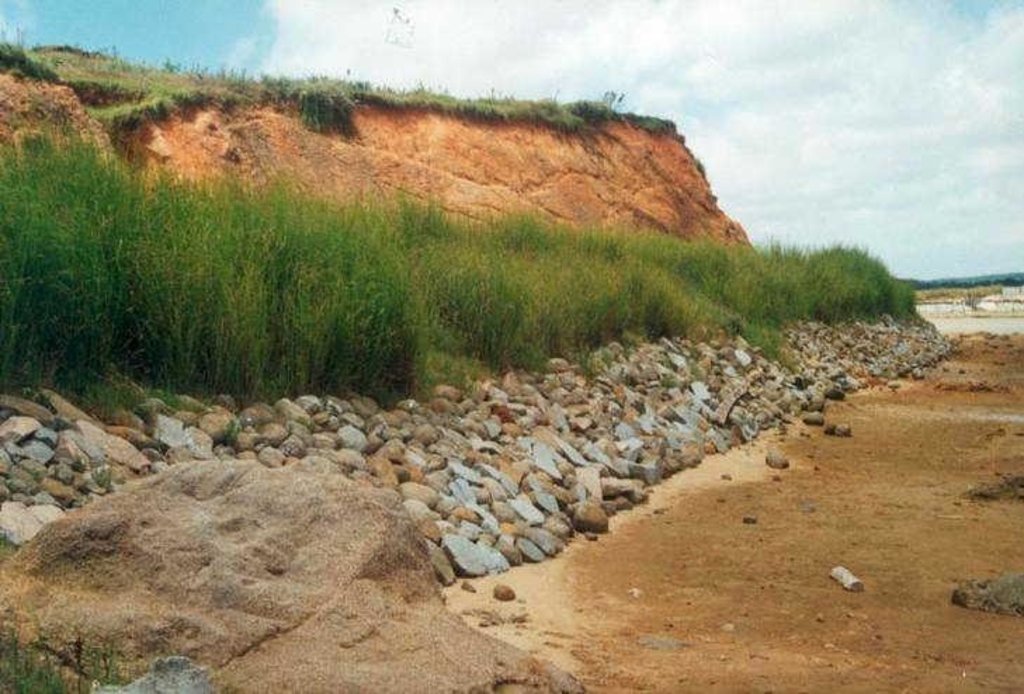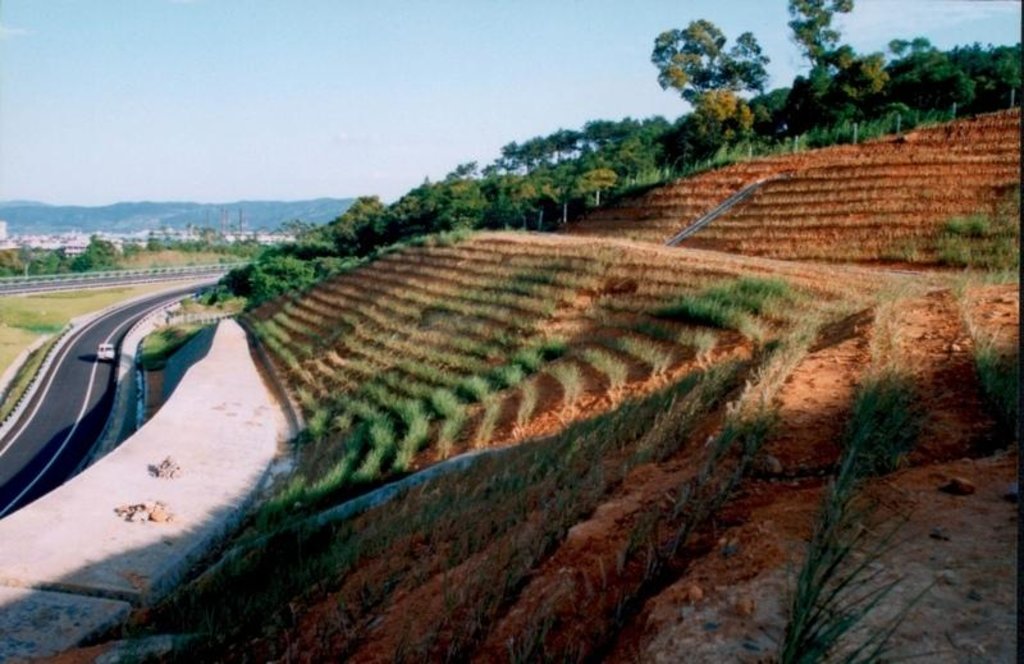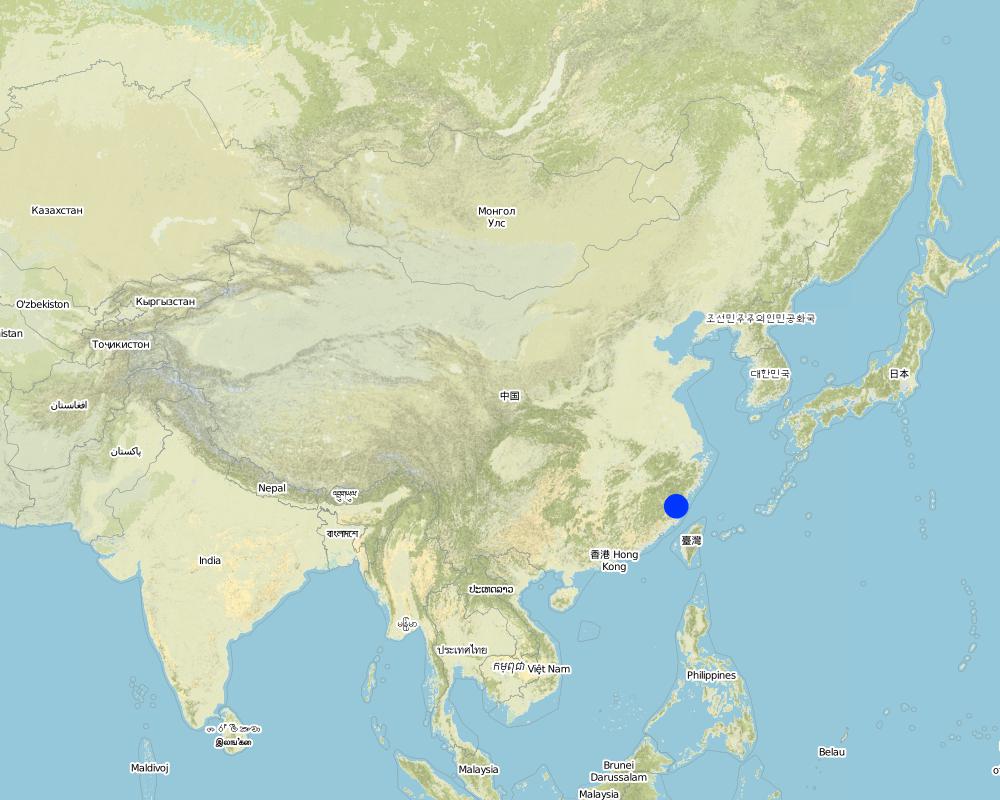Vetiver Hedge Barrier along Seashore and River bank [China]
- Creation:
- Update:
- Compiler: Unknown User
- Editor: –
- Reviewers: Alexandra Gavilano, David Streiff
vetiver hedge barrier in huo garden
technologies_961 - China
- Full summary as PDF
- Full summary as PDF for print
- Full summary in the browser
- Full summary (unformatted)
- Vetiver Hedge Barrier along Seashore and River bank: March 6, 2017 (inactive)
- Vetiver Hedge Barrier along Seashore and River bank: March 21, 2017 (inactive)
- Vetiver Hedge Barrier along Seashore and River bank: March 23, 2017 (inactive)
- Vetiver Hedge Barrier along Seashore and River bank: Sept. 4, 2019 (public)
View sections
Expand all Collapse all1. General information
1.2 Contact details of resource persons and institutions involved in the assessment and documentation of the Technology
Key resource person(s)
SLM specialist:
1.3 Conditions regarding the use of data documented through WOCAT
The compiler and key resource person(s) accept the conditions regarding the use of data documented through WOCAT:
Yes
2. Description of the SLM Technology
2.1 Short description of the Technology
Definition of the Technology:
Uprightness to the main windward, planting Vetiver hedge as barriers to prevent wind erosion.
2.2 Detailed description of the Technology
Description:
This technology is to use a good SWC vegetable --- Vetiver to form permanent hedge barrier. The barrier is upright to the main windward or along the river & dike bank. It is pruned 1-2 times after 2 months of planting. It can grow at about 1.5 m high within one year. Vetiver is a perennial plant, and has a strong fibrous roots, which can stretch 3 m beneath soils. It breeds by root & cane, and has strong adaptability. Vetiver is hygrophobe and can endure poor and saline-alkali soil. It is regarded as a saved money & low in labor input but with good benefits. This SWC technology is worth to be applied extensively.
2.3 Photos of the Technology
2.5 Country/ region/ locations where the Technology has been applied and which are covered by this assessment
Country:
China
Region/ State/ Province:
Fujian
Specify the spread of the Technology:
- evenly spread over an area
If the Technology is evenly spread over an area, specify area covered (in km2):
0.5
If precise area is not known, indicate approximate area covered:
- 0.1-1 km2
Comments:
Total area covered by the SLM Technology is 0.5 km2.
The SWC area is about 0.5 sqkm.
Map
×2.6 Date of implementation
If precise year is not known, indicate approximate date:
- less than 10 years ago (recently)
2.7 Introduction of the Technology
Specify how the Technology was introduced:
- through projects/ external interventions
Comments (type of project, etc.):
From India.
3. Classification of the SLM Technology
3.1 Main purpose(s) of the Technology
- reduce, prevent, restore land degradation
3.2 Current land use type(s) where the Technology is applied

Cropland
- Annual cropping
Annual cropping - Specify crops:
- fodder crops - grasses
- oilseed crops - groundnuts
- root/tuber crops - sweet potatoes, yams, taro/cocoyam, other
- rice, vetiver (fodder crop)
Number of growing seasons per year:
- 1
Specify:
Longest growing period in days: 365Longest growing period from month to month: Jan - Dec
Comments:
Main crops (cash and food crops):Rice-peanut-sweat potato, vetiver etc.
Major land use problems (compiler’s opinion): Serious wind erosion damages crops and cultivated land along the seashore.
Major land use problems (land users’ perception): Crops were often damaged and crop yield is decreasing gradually.
Type of cropping system and major crops comments: Rice-peanut-sweat potato etc.
3.4 Water supply
Water supply for the land on which the Technology is applied:
- rainfed
Comments:
Water supply also full irrigation
3.5 SLM group to which the Technology belongs
- surface water management (spring, river, lakes, sea)
3.6 SLM measures comprising the Technology

vegetative measures
- V1: Tree and shrub cover
3.7 Main types of land degradation addressed by the Technology

soil erosion by wind
- Et: loss of topsoil

chemical soil deterioration
- Cn: fertility decline and reduced organic matter content (not caused by erosion)

water degradation
- Ha: aridification
Comments:
Main type of degradation addressed: Et: loss of topsoil
Secondary types of degradation addressed: Cn: fertility decline and reduced organic matter content, Ha: aridification
4. Technical specifications, implementation activities, inputs, and costs
4.1 Technical drawing of the Technology
Technical specifications (related to technical drawing):
Technical knowledge required for field staff / advisors: low
Technical knowledge required for land users: moderate
Main technical functions: Wind-break
Secondary technical functions: improvement of ground cover, increase in organic matter, increase of infiltration, increase / maintain water stored in soil, water harvesting / increase water supply, Increase in soil fertility
Mulching
Material/ species: Vetiver
Quantity/ density: 10000
Remarks: alignment
Grass species: Vetiver
Slope (which determines the spacing indicated above): 30.00%
If the original slope has changed as a result of the Technology, the slope today is (see figure below): 20.00%
Gradient along the rows / strips: 50.00%
4.2 General information regarding the calculation of inputs and costs
Specify currency used for cost calculations:
- USD
If relevant, indicate exchange rate from USD to local currency (e.g. 1 USD = 79.9 Brazilian Real): 1 USD =:
8.3
Indicate average wage cost of hired labour per day:
3.61
4.3 Establishment activities
| Activity | Timing (season) | |
|---|---|---|
| 1. | treating material | mid-March |
| 2. | soil preparation | early March |
| 3. | planting | mid-March |
| 4. | water | planting day |
4.4 Costs and inputs needed for establishment
Comments:
Duration of establishment phase: 24 month(s)
4.5 Maintenance/ recurrent activities
| Activity | Timing/ frequency | |
|---|---|---|
| 1. | pruning | mid-May / |
| 2. | pruning | early June / |
| 3. | applying fertilizer | later May / |
4.6 Costs and inputs needed for maintenance/ recurrent activities (per year)
Comments:
Areas of vetiver cover.
4.7 Most important factors affecting the costs
Describe the most determinate factors affecting the costs:
seeds and labor.
5. Natural and human environment
5.1 Climate
Annual rainfall
- < 250 mm
- 251-500 mm
- 501-750 mm
- 751-1,000 mm
- 1,001-1,500 mm
- 1,501-2,000 mm
- 2,001-3,000 mm
- 3,001-4,000 mm
- > 4,000 mm
Specify average annual rainfall (if known), in mm:
1182.00
Agro-climatic zone
- humid
5.2 Topography
Slopes on average:
- flat (0-2%)
- gentle (3-5%)
- moderate (6-10%)
- rolling (11-15%)
- hilly (16-30%)
- steep (31-60%)
- very steep (>60%)
Landforms:
- plateau/plains
- ridges
- mountain slopes
- hill slopes
- footslopes
- valley floors
Altitudinal zone:
- 0-100 m a.s.l.
- 101-500 m a.s.l.
- 501-1,000 m a.s.l.
- 1,001-1,500 m a.s.l.
- 1,501-2,000 m a.s.l.
- 2,001-2,500 m a.s.l.
- 2,501-3,000 m a.s.l.
- 3,001-4,000 m a.s.l.
- > 4,000 m a.s.l.
Indicate if the Technology is specifically applied in:
- not relevant
5.3 Soils
Soil depth on average:
- very shallow (0-20 cm)
- shallow (21-50 cm)
- moderately deep (51-80 cm)
- deep (81-120 cm)
- very deep (> 120 cm)
Soil texture (topsoil):
- coarse/ light (sandy)
Topsoil organic matter:
- low (<1%)
If available, attach full soil description or specify the available information, e.g. soil type, soil PH/ acidity, Cation Exchange Capacity, nitrogen, salinity etc.
Soil fertility: very low
Soil drainage / infiltration: good
Soil water storage capacity: very low
5.6 Characteristics of land users applying the Technology
Off-farm income:
- less than 10% of all income
Relative level of wealth:
- average
Level of mechanization:
- manual work
- animal traction
Indicate other relevant characteristics of the land users:
Population density: 200-500 persons/km2
Annual population growth: < 0.5%
30% of the land users are average wealthy and own 20% of the land.
Off-farm income specification: This is an experimental project with small area so that not many persons involved in it.
5.8 Land ownership, land use rights, and water use rights
Land ownership:
- communal/ village
- individual, titled
6. Impacts and concluding statements
6.1 On-site impacts the Technology has shown
Ecological impacts
Water cycle/ runoff
surface runoff
Quantity before SLM:
60
Quantity after SLM:
35
Soil
soil loss
Quantity before SLM:
4.5
Quantity after SLM:
2
6.4 Cost-benefit analysis
How do the benefits compare with the establishment costs (from land users’ perspective)?
Short-term returns:
neutral/ balanced
Long-term returns:
very positive
How do the benefits compare with the maintenance/ recurrent costs (from land users' perspective)?
Short-term returns:
positive
Long-term returns:
very positive
6.5 Adoption of the Technology
- > 50%
If available, quantify (no. of households and/ or area covered):
100 households and 100% of the area
Of all those who have adopted the Technology, how many did so spontaneously, i.e. without receiving any material incentives/ payments?
- 51-90%
Comments:
50% of land user families have adopted the Technology with external material support
30 land user families have adopted the Technology with external material support
Comments on acceptance with external material support: estimates
50% of land user families have adopted the Technology without any external material support
30 land user families have adopted the Technology without any external material support
Comments on spontaneous adoption: estimates
There is a moderate trend towards spontaneous adoption of the Technology
Comments on adoption trend: Climate here is quite suitable for vetiver growing and it is easy to plant with low input and high output.
7. References and links
7.1 Methods/ sources of information
Links and modules
Expand all Collapse allLinks
No links
Modules
No modules





